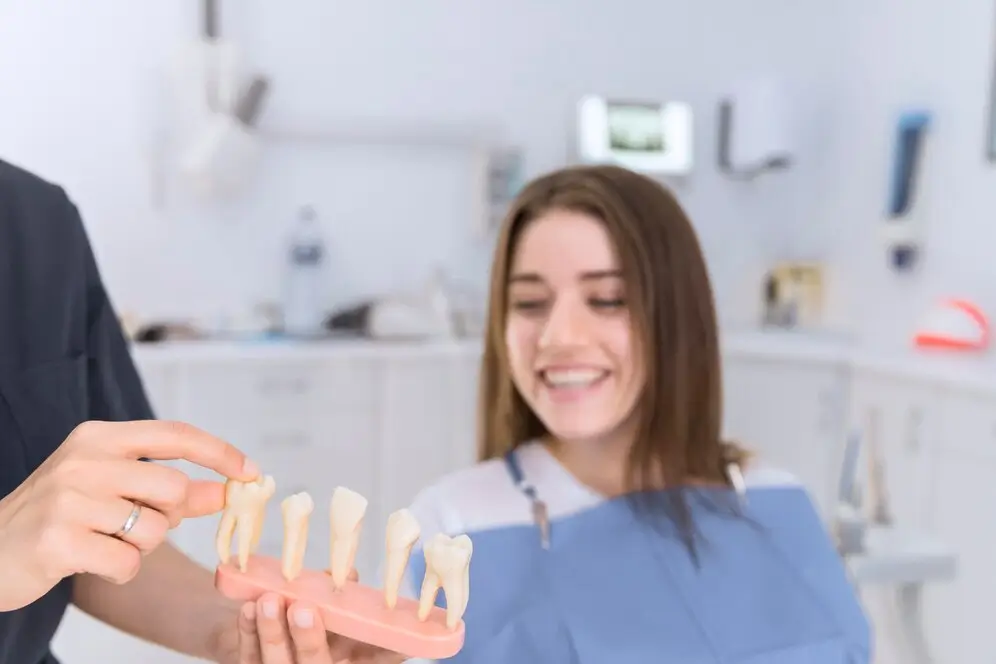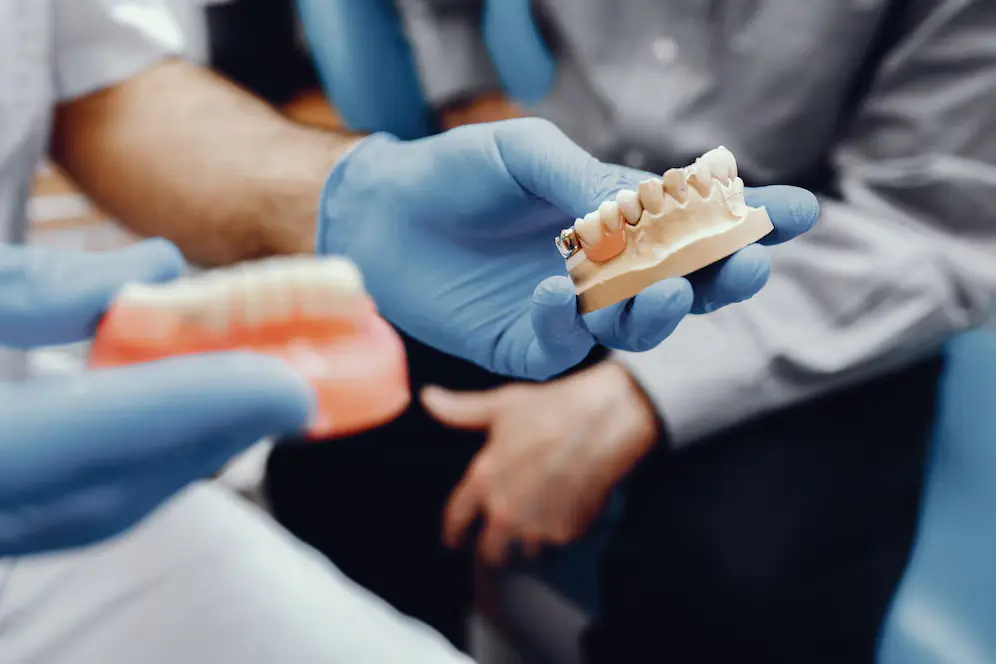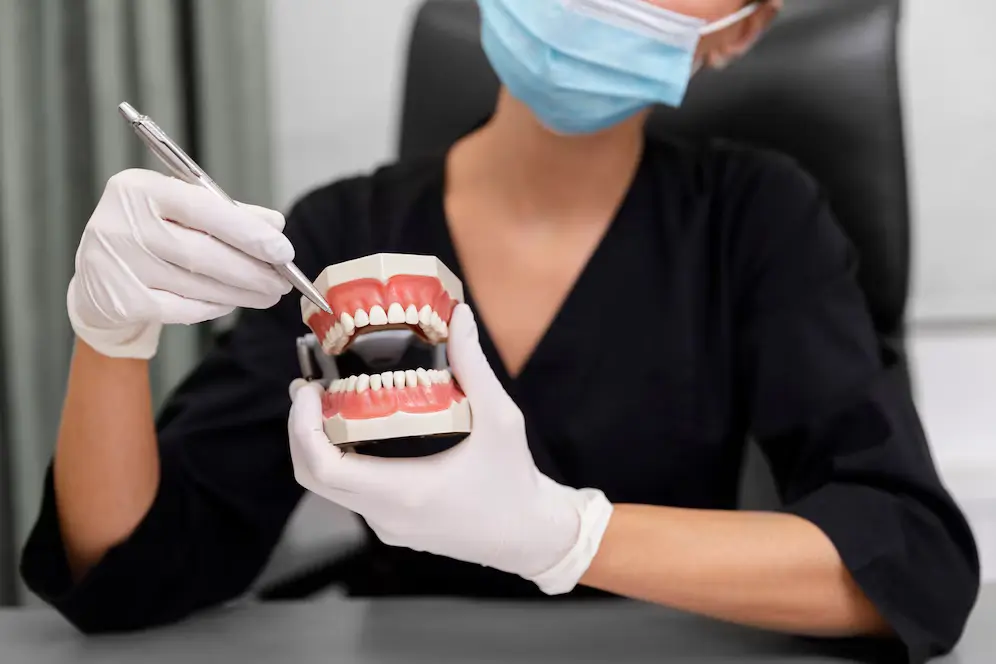What is a Dental Bridge
A dental bridge is a fixed dental restoration used to replace one or more missing teeth by “bridging” the gap between healthy teeth. It consists of one or more artificial teeth, also called pontics, held in place by surrounding teeth or dental implants. The supporting teeth or implants are called abutments, and they provide the necessary stability to keep the bridge secure. Bridges are custom-made to match the shape and color of your natural teeth, helping to restore your smile, chewing, and speech. Depending on the type, a bridge may have different configurations, but they all aim to restore a natural look and feel.
5 Types of Dental Bridges
There are several types of dental bridges available to suit different health needs, depending on how many teeth are missing and the condition of the surrounding teeth or gums. Some bridges are supported by natural teeth, while others rely on implants. Dentists consider many factors – like tooth location, bone health, and personal preference – when recommending the best option. Understanding the types of bridges can help you make a better decision about restoring your smile and oral function.

1. Traditional Dental Bridges
Traditional dental bridges are one of the most common types of dental bridges used to replace missing teeth. They work by placing types of crowns over the healthy teeth on either side of the gap, which serve as anchors. Between them, artificial teeth (called pontics) are positioned to restore your smile and chewing. This method is ideal if the teeth adjacent to the gap are strong enough to support the bridge. It’s a reliable and time-tested solution that looks natural and feels comfortable to use.
2. Cantilever Dental Bridges
Cantilever dental bridges are one of the types of bridges used when only one side of the missing tooth has a healthy natural tooth for support. Unlike traditional bridges, cantilever bridges use a single crown to hold the artificial tooth in place. The replacement tooth extends over the empty space, supported by just one abutment. While this design is useful when support is limited, it’s generally less durable than other bridge types and is not ideal for high-pressure chewing.
3. Maryland Bonded Bridges (Resin-Bonded Bridges)
Maryland bonded bridges, also called resin-bonded bridges, are more conservative different types of bridges. Instead of crowns, they use metal or porcelain wings attached to the back of nearby teeth to hold the artificial tooth in place. This method minimizes damage to healthy teeth and is often used to replace front teeth, where chewing pressure is lower. While they offer a less invasive option, Maryland bridges are not ideal for molars or other places that handle strong bite forces, as they can come loose under pressure.
4. Implant-Supported Bridges
Implant-supported bridges are one of the different types of bridges used when several teeth in a row are missing. Unlike traditional bridges, these are anchored to dental implants instead of natural teeth. Implants are surgically placed into the jawbone, acting as artificial roots. Once fully healed and fused with the bone – a process that may take a few months – the bridge is attached on top. This option offers excellent stability and is ideal for patients who don’t want to rely on surrounding natural teeth for support. It’s strong, long-lasting, and feels more like natural teeth.
5. Temporary Dental Bridges
Temporary dental bridges are a short-term solution used to fill gaps left by missing teeth while a permanent restoration is being prepared. Made from materials like acrylic or composite resin, these bridges are designed to closely match the shape and color of your natural teeth. They help maintain appearance and basic function during healing or lab work. As a type of bridges used in transitional care, they’re not meant for long-term wear but they protect your gums and smile until the final restoration is ready.

How to Choose the Right Type of Dental Bridge for You
Choosing the right dental bridge depends on a few things your dentist in Clifton will check. First, they’ll look at how many teeth are missing and how wide the gap is. They also need to examine the teeth on either side of the space to see if they’re healthy enough to support a bridge. Other important factors include your age (bridges usually aren’t used in kids), your gum health, and whether you have natural teeth on both sides of the gap. Your own preferences and lifestyle also matter. With all of this in mind, your dentist can recommend the best bridge options for missing teeth that will look good, feel good, and last as long as possible.
The Benefits of Dental Bridges for Your Oral Health
Here are some of the most notable benefits of all types of bridges:
- Restores function. Dental bridges help bring back your ability to chew food comfortably and speak clearly – something that’s often affected by missing teeth.
- Keeps your smile natural. Bridges are designed to fit in with your existing teeth, making your smile look natural.
- Maintains alignment. A dental bridge can stop surrounding teeth from drifting into the empty space, which makes your smile look better and helps you bite more comfortably.
- Improves confidence. Filling in the gap with a bridge can make you feel more comfortable and confident during regular daily activities like talking and smiling.
The Process of Getting a Dental Bridge
The procedure for getting a dental bridge can vary depending on the type, but let’s look at how the process works for the traditional bridge – one of the most commonly used ones. First, your dentist will numb the area with local anesthesia and reshape the supporting teeth on either side of the gap. Then, impressions are taken and sent to a lab to create your final bridge. While you wait, a temporary bridge is placed. At your second visit, the temporary bridge is removed, the final one is fitted, and then cemented in place. Some offices may even offer same-day CAD/CAM bridges. While there are different types of dental bridges, this one gives you a good idea of what to expect during a typical placement.

Dr. Doktorman Can Help You Choose the Best Dental Bridge
Choosing the best solution for your smile is easier with an experienced professional like Dr. Edward Doktorman. With years of practice and a personalized approach, Dr. Doktorman helps patients understand the benefits of each option, whether you’re comparing implants vs dentures or trying to decide between different types of bridges.
His gentle care, experience, and eye for detail make every visit comfortable and useful. From dental bridges to cosmetic care, he provides guidance based on what you really need, including advice on how long does teeth whitening last and how often you should go to the dentist for follow-ups.
Ready to make your smile beautiful again? Schedule your appointment with Dr. Doktorman today!
Conclusion
Choosing the right dental bridge depends on your oral health, the location of missing teeth, and your personal preferences. By understanding the different types of dental bridges, you can understand what your options are when discussing them with your dentist. Each type offers its own benefits, and the best choice will restore both function and appearance. With the right bridge, you can eat, speak, and smile naturally.
FAQs About Different Types of Dental Bridges
What Type of Dentist Does Bridges?
A general dentist with restorative training or a prosthodontist typically performs dental bridge procedures. These specialists are skilled in evaluating your oral health and recommending the best solution based on what works better for your case. They can explain the types of bridges and their names, like traditional, cantilever, Maryland, implant-supported, and temporary bridges.
How Long Do Dental Bridges Last?
Dental bridges usually last between 5 to 15 years, depending on your oral hygiene, diet, and overall dental care. With proper maintenance, some can last even longer. The lifespan may also vary slightly depending on the different types of dental bridges used, as materials and placement affect durability.
Is a Dental Bridge Painful?
Installing a dental bridge is usually not painful. But preparing the teeth for the bridge may cause some pain, so dentists use local anesthetics to make it painless and comfortable. This applies to most types of bridges for teeth.
Are Dental Bridges Better Than Dentures?
Dental bridges are often more stable and feel more natural than removable dentures, especially when replacing one or a few missing teeth. However, the best option depends on your oral health, budget, and personal preference. Your dentist can help you compare different types of tooth bridges and dentures to understand what’s the best for your unique case.
Do Bridges Feel Like Real Teeth?
Bridges are designed to look and feel like real teeth once your mouth adjusts to them. They are custom-made to match the shape and color of your natural teeth. Some dental bridge types may feel more natural than others depending on their materials and how they’re supported.







